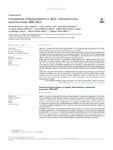Consumption of hypnosedatives in Spain: characterization and time trends, 2005-2022

View/
Use this link to cite
http://hdl.handle.net/2183/41196
Except where otherwise noted, this item's license is described as Creative Commons Attribution-NonCommercial-NoDerivatives 4.0 International License (CC-BY-NC-ND 4.0)
Collections
Metadata
Show full item recordTitle
Consumption of hypnosedatives in Spain: characterization and time trends, 2005-2022Alternative Title(s)
Consumo de hipnosedantes en España: caracterización y tendencias temporales, 2005-2022Author(s)
Date
2024-11-26Citation
Mourino N, Teijeiro A, Guerra-Tort C, Rey-Brandariz J, Candal-Pedreira C, Martín-Gisbert L, Mascareñas-García M, García G, Varela-Lema L, Pérez-Ríos M. Consumption of hypnosedatives in Spain: characterization and time trends, 2005-2022. Gac Sanit. 2024;38:102433.
Abstract
[Abstract]
Objective: To analyze the evolution of hypnosedative use in the Spanish population aged 15 to 64 (2005-2022), identifying regional variations and changes in users profile.
Method: We used data from the Survey on the Use of Alcohol and other Drugs in Spain. Past 30-day use was analyzed by sex, age and autonomous community between 2005 and 2022. A multivariate logistic regression was used to identify characteristics of consumption; the temporal trend of prevalence and adjusted odds ratio were evaluated using joinpoint regression models.
Results: Between 2005 and 2022, the prevalence of hypnosedative use in Spain increased (from 3.7% to 9.7%) with an annual percentage change of 4.7%. The maximum increase was observed among women aged 55 to 64, reaching a prevalence of 21.4% in 2022. Use increased in all autonomous communities, with Cantabria, La Rioja and Andalusia standing out. The likelihood of using hypnosedatives was higher among women, the oldest age groups, those with basic or intermediate education, those unemployed or economically inactive, those not living with a partner or family, Spanish citizens, and tobacco or cannabis users.
Conclusions: An upward trend in the use of hypnosedatives in Spain has been observed since 2005, with variations according to sex, age, and autonomous community. It is crucial to update regional addiction plans, promote preventive strategies and foster collaboration between health authorities, medical professionals and the population to address mental health inequalities and ensure adequate care and responsible prescribing. [Resumen] Objetivo. Analizar la evolución del consumo de hipnosedantes en la población española de 15 a 64 años desde 2005 hasta 2022, identificando variaciones regionales y cambios en el perfil de los consumidores.
Método. Se utilizaron datos de la Encuesta sobre Uso de Alcohol y otras Drogas en España. Se analizó el consumo en los últimos 30 días, desglosado por sexo, edad y comunidad autónoma entre 2005 y 2022. Se realizó una regresión logística multivariante para identificar las características asociadas al consumo y se evaluó la tendencia temporal de las prevalencias y las odds ratio ajustadas utilizando modelos de regresión joinpoint.
Resultados. Entre 2005 y 2022 aumentó la prevalencia de consumo (del 3,7% al 9,7%), con un porcentaje de cambio anual del 4,7%. El mayor incremento se observó en mujeres de 55 a 64 años, alcanzando una prevalencia de 21,4% en 2022. En todas las comunidades autónomas aumentó el consumo, destacando Cantabria, La Rioja y Andalucía. La probabilidad de consumir hipnosedantes fue mayor en las mujeres, en los de mayor edad, con nivel educativo básico o medio, desempleados o inactivos laboralmente, que no conviven con pareja o familia, de nacionalidad española y consumidores de tabaco o cannabis.
Conclusiones. En España se observa un aumento del consumo de hipnosedantes desde 2005, con variaciones por sexo, edad y comunidad autónoma. Es crucial actualizar los planes regionales de adicciones, promover estrategias preventivas y la colaboración entre autoridades sanitarias, profesionales médicos y la población para abordar las desigualdades en salud mental y asegurar una atención adecuada y una prescripción responsable.
Keywords
Hypnotics and sedatives
Prevalence
Spain
Adults
Addictive behavior
Hipnóticos y sedantes
Prevalencia
España
Adultos
Conducta adictiva
Prevalence
Spain
Adults
Addictive behavior
Hipnóticos y sedantes
Prevalencia
España
Adultos
Conducta adictiva
Editor version
Rights
Creative Commons Attribution-NonCommercial-NoDerivatives 4.0 International License (CC-BY-NC-ND 4.0)
ISSN
0213-9111






